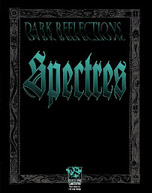
Reviewed by Mike Spera There are some things that are worse than death. Living in eternal agony as a creature spawned from the pits of Hell itself is only one of them. Dark Reflections: Spectres shows us what it's like to be the "bad guy," who may actually not seem so hideous now that the method to their madness is revealed. Spectres is released on the Black Dog label, and by looking at the artwork done by John Cobb, Guy Davis, Jason Felix, Vince Locke, H.J. McKinney, E. Allen Smith, and Joshua Gabriel Timbrook, I can see why. The art is unsettling, with blood, hooks, chains, pins, needles, and other things that look straight from the pits of Hell or off the set of Clive Barker's Hellraiser. But the content of the book itself is just as dark as any other Wraith: The Oblivion supplement, Black Dog or not. Still, I have seen many disturbing fictional things in my age, so perhaps I'm desensitized to the murder and mayhem that other gamers are taken aback by. I leave the final decision up to you. The opening fiction is decent enough, it's dark and moody and wickedly delicious. The Introduction gives a brief and broad description of spectres as a whole, followed by a chapter-by-chapter breakdown and summary, ending with a lexicon of terms used by the most damned of the damned. Chapter One: Spectral Culture begins with various factions' opinions of spectres. From Hierarchy to Renegade to Heretic, from vampire to werewolf to mage, they all give their thoughts. Surprisingly, some of them do NOT view spectres as "evil spirits that must be killed at all costs." Some view the mad ghosts of Oblivion as pitiable, even necessary. Following that are spectral characteristics. Deathsight, dimmed senses, the Hive... all that and more are covered here. This is where we get a real sense of the tragedy of spectral existence. Spectres live very brief lives. Thrown into Oblivion, these damned souls exist for only one reason: Oblivion lets them. If you choose to play a spectre, you exist on borrowed time, and will eventually succumb to the Void and cease to exist. Serving a force of nature that would kill you as soon as reward you, that is the insane paradox that the spectres live. After spectral characteristics are explained, there is a brief overview of spectral history and an analysis of what they are, what they do, why they do it, and who they serve. Finally, the caste system of respect and power are broken down, going from weakest to strongest. I MUST WARN YOU, however, that if you are thinking of buying this book for the "new" spectral castes, you will be disappointed. There are 5 castes explained here: Dopplegangers, Nephwracks, Shades, Mortwights, Striplings, and Malfeans. Those same 5 castes are mentioned and explained in the Wraith: The Oblivion rulebook. The five castes in this book are not new, they are simply expanded. For all new castes, try to get your hands on a copy of Doomslayers: Into The Labyrinth. Dark Reflections has the same types of spectres that Wraith does, only fleshed out much, much more. Chapter Two: Spectres As Characters gives a complete and detailed synopsis of creating a creature of Oblivion. Again, the fact is driven home that by playing a spectre, you've all ready lost, and are living on borrowed time. Oblivion is a master that is feared just as much as it is worshiped. The initial steps (Concept, Attributes, and Abilities) are pretty much the same as any wraith character. It is in the Advantages stage that our Oblivion-devoured Restless differ from their more wholesome counterparts. Each caste has a different approach to Arcanos and Dark Arcanos since each caste become spectres in a different way. Who can have Fetters, who can have Arcanos, and who has an automatic dot in Hive-mind is all covered here. There is a new background called Shadowlands, and that represents what your character knows (if anything) about the lands where the rest of the dead spend their afterlives. Next, Angst, Being, and Corpus are all covered. Finally, there are Merits, Flaws, Dark Arcanoi, Dramatic Systems, and more to give your character that spark of death that all spectres need. Chapter Three: Spectres And The Storyteller is all about drama and running a spectral chronicle. Things such as mood, theme, death, decay, horror, hate, fear, insanity, plot hooks, story concepts, chronicle ideas, "Spectre versus X" conflicts... all that is covered here. This gives method to the madness of the Shadow-Eaten, and further explains from their own point of view why they seek to kill themselves and everything around them. Things such as Being, Emoting (see the lexicon in the Introduction) and experience points are explained, as well as that one minor annoying detail that every spectre hates: the tiny voice in their head that is (or was) their Psyche. Chapter Four: Templates is an extremely brief chapter with some premade spectre characters that work as antagonists, inspiration, or as spectral anti-heroes. There's the Doppleganger Impostor, Demonic Nephwrack, Stripling Prodigy, Mortwight True Believer, and the Rampaging Shade. At the end, there is a new character sheet for spectres and a Psyche sheet that acts like the Shadow sheet does in the core rulebook. In the end, if you want or need anything for spectres, this is the best place to start. There's more info in other books about them, but this is about 90% of the spectre-specific info. Dark Reflections: Spectres brings a method for the madness for the most damned of the damned. 4 out of 5 skulls. Reviews on the Wraith Project are the opinions of those reviewers, and are not necessarily those of the Wraith Project themselves. If you disagree with this review, send in another one. If you still feel like strangling the reviewer, see an analyst. |
